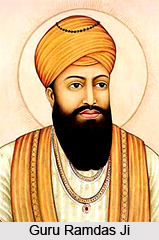 Guru Ramdas Ji was born in Lahore in Punjab on 24th September 1534 to Hari Das and his mother Anoop Devi. Guru Ramdas Ji was the Chautbi Patshahi or the fourth Guru of Sikhs. He kept alive the tradition of the first three Gurus among his descendants and he reigned as the Guru of Sikhs, for a very short period. He somehow became successful to manage to get a land where he laid the foundation of a new town named Ramdaspur and this town later changed its name to Amritsar.
Guru Ramdas Ji was born in Lahore in Punjab on 24th September 1534 to Hari Das and his mother Anoop Devi. Guru Ramdas Ji was the Chautbi Patshahi or the fourth Guru of Sikhs. He kept alive the tradition of the first three Gurus among his descendants and he reigned as the Guru of Sikhs, for a very short period. He somehow became successful to manage to get a land where he laid the foundation of a new town named Ramdaspur and this town later changed its name to Amritsar.
Guru Ramdas Ji dug a tank in Amritsar that also became the principal place of pilgrimage. He had the habit of generously inviting the traders and businessmen to the town and the town also became an important trade and religious centre in Northern India, by the course of time.
The tank of Amritsar that Guru Ramdas Ji dug during his reign became very famous for "Ramdas Sarovar Nahate, Sab uttre paap kamdte" and the Sikh community believes that taking bath in the tank washes away all the sins. The city of Amritsar for the Sikhs is like what is Mecca is for the Muslims. His works reveal one thing that the Guru did have his own mission and he also tried to do everything for establishing his mission as a separate religious system and entity. He was given the title of Sikh Guru on 30 August 1574.
One of his main contributions to Sikhism was organizing the structure of Sikh society. He was the author of Laava, the four hymns of the Sikh Marriage Rites. The standard Sikh marriage ceremony known as the Anand Karaj is a four-stanza hymn composed by Guru Ram Das ji.
He died on 1 September 1581, in the city of Amritsar, Punjab
This article is a stub. You can enrich by adding more information to it. Send your Write Up to content@indianetzone.com




















